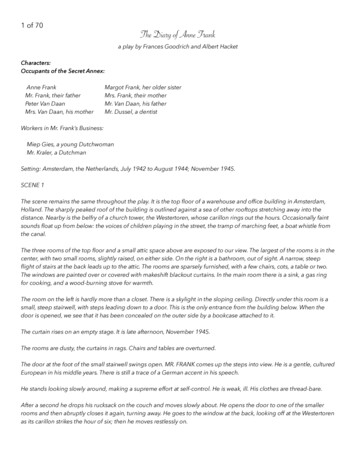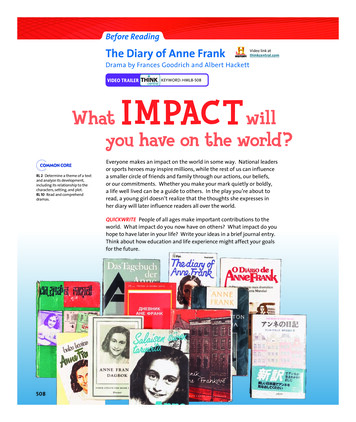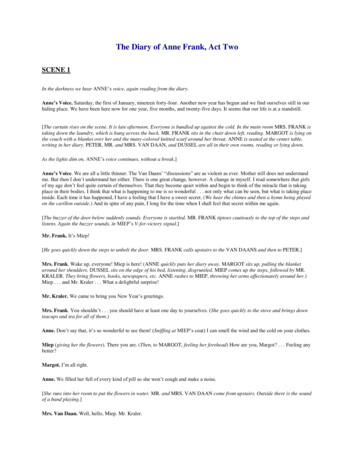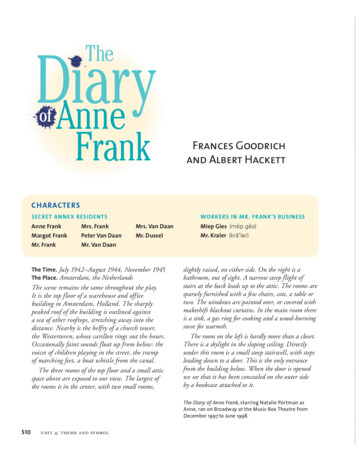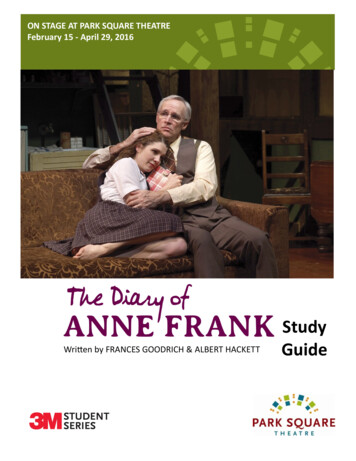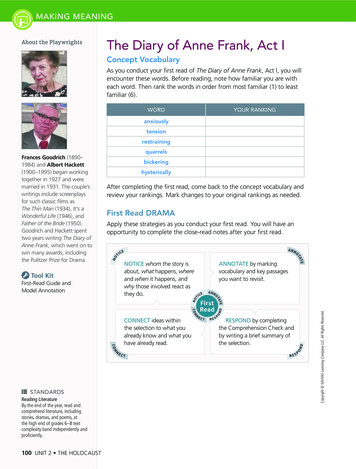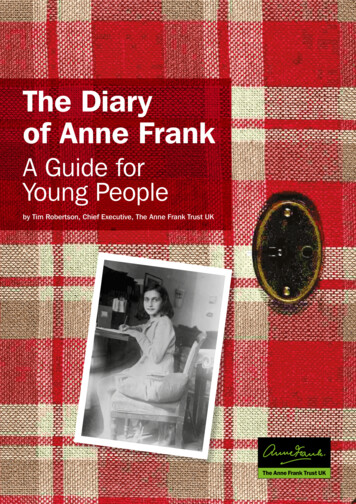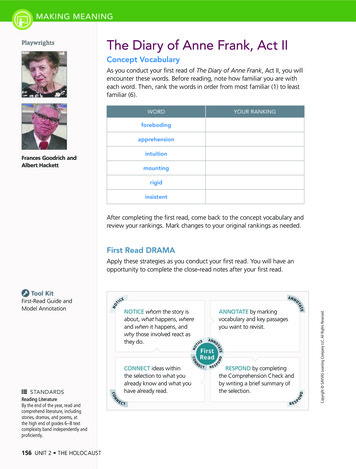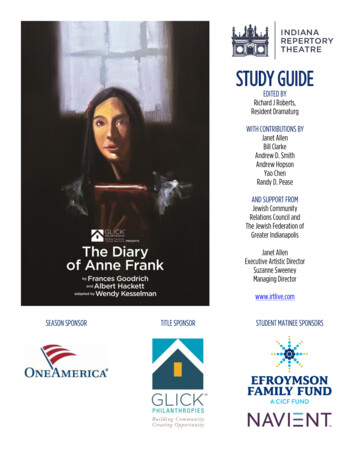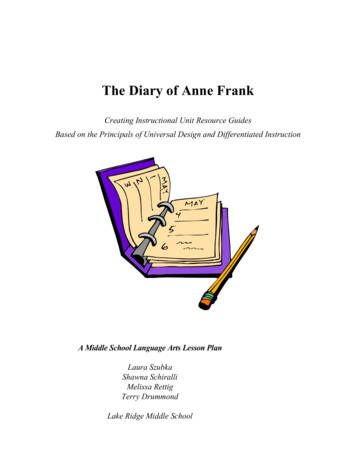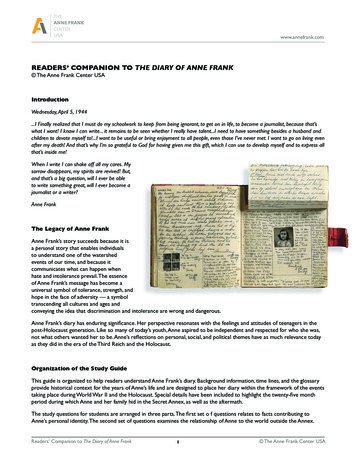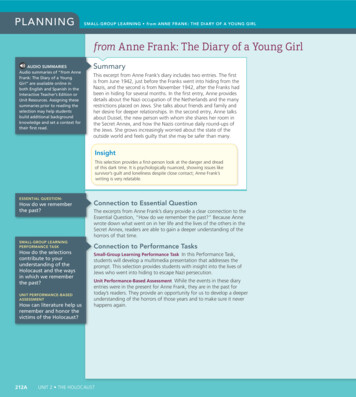
Transcription
PLANNINGSMALL- GROUP LEARNING from ANNE FRANK: THE DIARY OF A YOUNG GIRLfrom Anne Frank: The Diary of a Young GirlAudio SummariesAudio summaries of “from AnneFrank: The Diary of a YoungGirl” are available online inboth English and Spanish in theInteractive Teacher’s Edition orUnit Resources. Assigning thesesummaries prior to reading theselection may help studentsbuild additional backgroundknowledge and set a context fortheir first read.SummaryThis excerpt from Anne Frank’s diary includes two entries. The firstis from June 1942, just before the Franks went into hiding from theNazis, and the second is from November 1942, after the Franks hadbeen in hiding for several months. In the first entry, Anne providesdetails about the Nazi occupation of the Netherlands and the manyrestrictions placed on Jews. She talks about friends and family andher desire for deeper relationships. In the second entry, Anne talksabout Dussel, the new person with whom she shares her room inthe Secret Annex, and how the Nazis continue daily round-ups ofthe Jews. She grows increasingly worried about the state of theoutside world and feels guilty that she may be safer than many.InsightThis selection provides a first-person look at the danger and dreadof this dark time. It is psychologically nuanced, showing issues likesurvivor’s guilt and loneliness despite close contact; Anne Frank’swriting is very relatable.Essential Question:How do we rememberthe past?Small-Group LearningPerformance TaskHow do the selectionscontribute to yourunderstanding of theHolocaust and the waysin which we rememberthe past?Unit Performance-BasedAssessmentHow can literature help usremember and honor thevictims of the Holocaust?212AConnection to Essential QuestionThe excerpts from Anne Frank’s diary provide a clear connection to theEssential Question, “How do we remember the past?” Because Annewrote down what went on in her life and the lives of the others in theSecret Annex, readers are able to gain a deeper understanding of thehorrors of that time.Connection to Performance TasksSmall-Group Learning Performance Task In this Performance Task,students will develop a multimedia presentation that addresses theprompt. This selection provides students with insight into the lives ofJews who went into hiding to escape Nazi persecution.Unit Performance-Based Assessment While the events in these diaryentries were in the present for Anne Frank, they are in the past fortoday’s readers. They provide an opportunity for us to develop a deeperunderstanding of the horrors of those years and to make sure it neverhappens again.UNIT 2 THE HOLOCAUST
hlightsELHighlightsOnlineAssessmentLESSON RESOURCESLessonMaking MeaningLanguage DevelopmentEffective ExpressionFirst ReadConcept VocabularySpeaking and ListeningClose ReadWord StudyAnalyze the TextAuthor’s StyleAnalyze Craft and StructureInstructionalStandardsRI.10 By the end of the year, read andcomprehend literary nonfiction . . .L.4 Determine or clarify the meaningof unknown and multiple-meaningwords or phrases . . .L.4.a Use context as a clue . . .RI.2 Determine a central ideaof a text . . .RI.1 Cite the textual evidenceL.4 Determine or clarify the meaningof unknown and multiple-meaningwords or phrases . . .L.4.b Use common, grade-appropriateGreek or Latin affixes and roots . . .L.4.d Verify the preliminarydetermination . . .SL.1 Engage effectively in a range ofcollaborative discussions . . .SL.1.a Come to discussionsprepared . . .SL.1.c Pose questions . . .SL.1.d Acknowledge newinformation . . .RI.4 Determine the meaning of wordsand phrases . . .RI.5 Analyze in detail the structure ofa specific paragraph in a text . . .STUDENT RESOURCESAvailable online in theInteractive StudentEdition or Unit ResourcesSelection AudioWord NetworkEvidence Log oncept Vocabulary andCWord StudyS peaking and Listening: GroupDiscussionFirst-Read Guide: NonfictionClose-Read Guide: NonfictionTEACHER RESOURCESSelection ResourcesAvailable online in theInteractive Teacher’sEdition or Unit ResourcesAudio SummariesAnnotation HighlightsEL Highlights from Anne Frank: The Diary of aYoung Girl: Text QuestionsAuthor’s Style: Word ChoiceE nglish Language SupportLesson: Word Choices nalyze Craft and Structure:ACentral Idea and Supporting DetailsReteach/Practice (RP)Available online in theInteractive Teacher’sEdition or Unit ResourcesAssessmentAvailable onlinein AssessmentsMy Resources nalyze Craft and Structure:ACentral Idea and SupportingDetails (RP)Word Study: Latin Root -strict- (RP)Author’s Style: Word Choice (RP)S peaking and Listening: GroupDiscussion (RP)Selection TestA Unit 2 Answer Key is available online and in the Interactive Teacher’s Edition.Small-Group Learning212B
PERSONALIZE FOR LEARNINGSMALL- GROUP LEARNING from ANNE FR ANK:THE DIARY OF A YOUNG GIRLReading SupportText Complexity Rubric: from Anne Frank: The Diary of a Young GirlQuantitative MeasuresLexile: 1010 Text Length: 1,317 wordsQualitative MeasuresKnowledge Demands12345Content about the Nazi occupation, Hitler, concentration camps, and anti-Jewish sentiments and laws maynot be familiar to readers, though these topics are clearly explained.345Letter-writing structure in diary breaks up text; labels of dates for each letter in the diary help reader identifythe time frame of the excerpts.Structure12Language Conventionality and Clarity12345The writing is conversational. But the diary was translated from the Dutch in the 1940s, so it has an older,formal style. There is some difficult vocabulary and figurative language.5Some concepts are sophisticated, but concepts and situations are clearly explained, as are Anne’s feelings,attitudes, and opinions about the larger significance of the conditions.Levels of Meaning/Purpose1234Decide and PlanEnglish Language SupportStrategic SupportChallengeProvide English Learners with support forknowledge demands and language as theyread the selection.Provide students with strategic supportto ensure that they can successfully readthe text.Provide students who need to be challengedwith ideas for how they can go beyond asimple interpretation of the text.Knowledge Demands Review thebackground information that studentsdiscussed when they read the play based onAnne Frank’s diary. (See English LanguageSupport, Acts I and II of The Diary of AnneFrank in Whole-Class Learning.)Language Discuss the saying Paper is morepatient than man. (paragraph 1) Remindstudents that Anne Frank is referring to herdiary. Ask students what they think thismeans about writing and how Anne feelswhen she writes.Language Point out phrasing or sentencesthat may be unfamiliar because of the timethey were written or the style of writing.For example, the expression there is nodoubt (paragraph 1) gives emphasis orshows agreement. The phrase failing that(paragraph 2) means “if it doesn’t happen.”The phrase enhance in my mind’s eye(paragraph 3) is a poetic way of talkingabout what she is imagining.Ask students to list unfamiliar phrases orwords (see English Language support forexamples) and explain as needed.Text Analysis Have students work in pairs.Ask them to reread the last few paragraphs,focusing on the range of emotions Annedescribes, for example, scared, fortunate,sad, or guilty. Ask them to write examplesfrom the text. Discuss as a group. Then talkabout other feelings people could have inthis situation, such as anger, frustration,or despair.Meaning Discuss the events, for example,the family’s emigration to Holland in 1933or the arrival of the Germans in 1940. Then,with students, list some of the feelingsand attitudes. For example, in the lastparagraphs, Anne describes a range ofemotions: fortunate, sad, “wicked” (guilty),and frightened.Written Response Have students work inpairs to discuss and list their responses tothe text. As a group, have partners share.Then ask volunteers to say positive thingsthey can find in Anne Frank’s attitudes, orpositive things people can do to respond toa horrific event such as this one.TEACHRead and RespondHave the groups do their first read of the selection. Then have them complete their close read. Finally,work with them on the Making Meaning, Language Development, and Effective Expression activities.212CUNIT 2 THE HOLOCAUST
Standards Support Through Teaching and Learning CycleIDENTIFY NEEDSAnalyze results of the Beginningof-Year Assessment, focusing onthe items relating to Unit 2. Alsotake into consideration studentperformance to this point andyour observations of whereparticular students struggle.DECIDE AND PLAN If students have performed poorly on items matching these standards, then provide selectionscaffolds before assigning them the on-level lesson provided in the Student Edition. If students have done well on the Beginning-of-Year Assessment, then challenge them tokeep progressing and learning by giving them opportunities to practice the skills in depth. Use the Selection Resources listed on the Planning pages for Anne Frank: The Diary of aYoung Girl to help students continually improve their ability to master the standards.Instructional Standards: from Anne Frank: The Diary of a Young GirlReadingYou may wish to administer theAnalyze Craft and Structure:Central Idea and SupportingDetails (RP) worksheet tohelp students recognize andunderstand a text’s central ideaand supporting details.RI.2 Determine a centralidea of a text and analyze itsdevelopment over the courseof the text, including itsrelationship to supporting ideas;provide an objective summary ofthe text.You may wish to administerthe Author’s Style: WordChoice (RP) worksheet to helpstudents consider the way awirter’s word choices impactstyle and meaning.RI.4 Determine the meaningof words and phrases as theyare used in a text, includingfigurative, connotative, andtechnical meanings; analyzethe impact of specific wordchoices on meaning and tone,including analogies or allusionsto other texts.LanguageYou may wish to administerthe Word Study: Latin Root-strict- (RP) worksheet tohelp students identify andunderstand words with the-tion suffix.L.4.b Use common,grade‑appropriate Greek or Latinaffixes and roots as clues to themeaning of a word.SpeakingandListeningYou may wish to administerthe Speaking and Listening:Group Discussion (RP)worksheet to help studentsget the most out of groupdiscussions.Work with students to driveSL.1 Engage effectivelygroup discussions that supportin a range of collaborativediscussions with diverse partners new topics.on grade 8 topics, texts, andissues, building on others’ ideasand expressing their own clearly.ANALYZE AND REVISE Analyze student work forevidence of student learning. Identify whether or notstudents have met theexpectations in the standards. Identify implications for futureinstruction.TEACHImplement the planned lesson,and gather evidence of studentlearning.Ask students to read anonfiction text of their ownchoosing. Have them write asentence or two telling theselection’s central idea. Thenhave them give two or threeexamples of evidence fromthe text that supports thiscentral idea.Challenge students to findanother text with a moreformal diction and have themcompare the effect of wordchoice on the reader.Work with students to findthree verbs that they canturn into nouns by adding-tion. Have them use each ofthe words in a sentence thatincludes context clues.Small-Group Learning212D
MAKING MEANINGAbout the AuthorJump StartFirst Read How can someone get used toliving in hiding with others? What can peopledo to stay strong? Engage students in adiscussion about ways of coping with extremelydangerous situations that sets the context forreading the excerpt from Anne Frank: The Diaryof a Young Girl.from Anne Frank: The Diaryof a Young GirlHow did people try to survive, even during Hitler’srule? Modeling questions such as this will helpstudents connect to the excerpt from Anne Frank:The Diary of a Young Girl and to the Small-GroupPerformance Task assignment. Selection audioand print capability for the selection are availablein the Interactive Teacher’s Edition.Concept VocabularyYou will encounter the following words as you read the excerpt fromAnne Frank: The Diary of a Young Girl.Anne Frank (1929–1945)was a young girl who livedin Amsterdam with herfamily during World WarII. Fleeing Nazi persecutionof Jews, the Frankswent into hiding, whereAnne began writing herthoughts, experiences, andobservations in a diary. Shewas 15 when the familywas found and sent tothe concentration camps.Anne and her sister diedat Bergen-Belsen, justweeks before the campwas liberated.Concept VocabularyAsk groups to look closely at the informationabout context clues and discuss how these typesof clues can help clarify a word’s meaning. Havestudents discuss the examples and encouragegroups to use context clues as they come acrossadditional unfamiliar words.Tool KitFirst-Read Guide andModel AnnotationFIRST READHave students perform the steps of the firstread independently:NOTICE: You may want to encourage students tonotice key events that Anne relates.ANNOTATE: Remind students to markpassages that include the main ideas and detailsin the diary.CONNECT: Have students compare Anne Frank’sdiary with the play about her life, and with thewritings of other young people.RESPOND: Students will answer questions andwrite a summary to demonstrate understanding.Point out to students that while they will alwayscomplete the Respond step at the end of thefirst read, the other steps will probably happensomewhat concurrently. You may wish to printcopies of the First-Read Guide: Nonfiction forstudents to use.212UNIT 2 THE HOLOCAUSTfrom Anne Frank: The Diaryof a Young GirlforbiddenrestrictionssacrificesContext Clues If these words are unfamiliar to you, try using contextclues—other words and phrases that appear nearby in the text—to helpyou determine their meanings. There are various types of context cluesthat may help you unlock word meanings.Synonyms: The bifurcated tree branch looked remarkably similar toa snake’s forked tongue.Restatement: A healthful breakfast can invigorate you, giving youthe energy you need to get through your morning.Contrast of Ideas: The first crate looked cumbersome, so Igrabbed the second one, which was small and easy to handle.Apply your knowledge of context clues and other vocabulary strategiesto determine the meanings of unfamiliar words you encounter duringyour first read.First Read NONFICTIONApply these strategies as you conduct your first read. You will have anopportunity to complete a close read after your first read.NOTICE the general ideasof the text. What is it about?Who is involved?ANNOTATE by markingvocabulary and key passagesyou want to revisit.CONNECT ideas withinthe selection to what youalready know and what youhave already read.RESPOND by completingthe Comprehension Check andby writing a brief summary ofthe selection. STANDARDSReading Informational TextBy the end of the year, read andcomprehend literary nonfiction atthe high end of the grades 6–8 textcomplexity band independently andproficiently.LanguageDetermine or clarify the meaningof unknown and multiple-meaningwords or phrases based on grade8 reading and content, choosingflexibly from a range of strategies. Pearson Education, Inc., or its affiliates. All rights reserved.FACILITATINGa. Use context as a clue to themeaning of a word or phrase.212 UNIT 2 The holocAUsTAuthor's PerspectiveLIT17 SE08 U02 B1 SG.indd 212Jim Cummins, Ph.D.Importance of Background Knowledge Itis important for all students, and especiallyfor English learners, to learn to tap into theirbackground knowledge when they read a text.Teachers can help students access this knowledgeand integrate it with new textual information.One way to do this is to encourage groups toshare what they know about the topic of thetext before they begin reading. For example,some students may have prior knowledgeabout the Holocaust, which can help scaffoldunderstanding of Anne Frank: The Diary of aYoung Girl. On a deeper level, more studentsmay be able to relate to the idea of writing theirmost personal thoughts in a diary. After studentshave completed their first read, have them discusshow their background knowledge helped themunderstand the text.16-04-27 6:15 PM
Name:Date:First-Read GuideUse this page to record your first-read ideas.ANNOTATE by marking vocabulary andkey passages you want to revisit.NOTICE new information or ideas youlearned about the unit topic as you firstread this text.ANNFirstReadNTRESPRESPOND by writing a brief summary ofthe selection.NNECONCODECODEONNOCONCONNECT ideas within the selection toother knowledge and other selectionsyou have read.ICOTETATNOANNIC ETETATSelection Title:T STANDARD Anchor Reading Standard 10 Read and comprehend complex literary andinformational texts independently and proficiently. Pearson Education, Inc., or its affiliates. All rights reserved.RESP
Name:Date:from Anne Frank: The Diary of a Young GirlAnne FrankDIRECTIONS:Respond to these questions. Use textual evidence to support yourresponses.1.(a) Interpret What does the saying “paper is more patient than man” mean?(b) Draw Conclusions Why does Anne choose to begin her diary with thatobservation?2.(a) What were the “Anti-Jewish decrees”? (b) Analyze How do those decrees affectAnne’s outlook on life?3.(a) What leads Anne to believe that Dussel isn’t prepared for living in the annex?(b) Analyze In what way is Anne’s observation about Dussel surprising, given thatshe is so much younger than he?4.(a) What news of the outside world does Mr. Dussel bring?(b) Connect Why does this news make Anne feel guilty about living in the annex?What insight about Anne does her guilt reveal? Pearson Education, Inc. or its affiliates. All rights reserved.1
FIRST READ EXTENSION QUESTIONSfrom Anne Frank: The Diary of a Young GirlName:Date:from Anne Frank: The Diary of a Young GirlAnne FrankDIRECTIONS:Complete the following items after you have read the text.RI.8.4 Determine the meaning of words and phrases as they are used in a text, includingfigurative, connotative, and technical meanings; analyze the impact of specific word choiceson meaning and tone, including analogies or allusions to other texts.1. (a) Determine the meaning of figurative language.In paragraph 1 of the excerpt from Anne Frank: The Diary of a Young Girl, Annequotes the saying “paper is more patient than man.” What does she mean by thissaying?(b) Analyze the impact of analogies and allusions on meaning.Explain the impact of this saying on Anne’s meaning. First, restate Anne’s mainreason for keeping a diary. Then, explain how the comparison in the saying helpsemphasize this reason.RI.8.2 Determine a central idea of a text and analyze its development over the course of thetext, including its relationship to supporting ideas; provide an objective summary of the text.2. (a) Determine a central idea.In the excerpt from Anne Frank: The Diary of a Young Girl, what central ideadoes Anne develop in paragraphs 5 and 6?(b) Analyze its relationship to supporting ideas.What is the main type of supporting detail Anne offers for this central idea?Give an example from the text.(c) Analyze its development over the course of the text.In paragraph 6, what related idea does Anne add to this central idea? Why is thisrelated idea important to readers’ understanding? Pearson Education, Inc., or its affiliates. All Rights Reserved.1
FIRST READ EXTENSION QUESTIONSfrom Anne Frank: The Diary of a Young GirlRI.8.1 Cite the textual evidence that most strongly supports an analysis of what the text saysexplicitly as well as inferences drawn from the text.3. (a) Draw an inference from the text.From the excerpt from Anne Frank: The Diary of a Young Girl, what can youinfer Anne feels about sharing a room with Mr. Dussel?(b) Cite evidence to support your inference.What details in the text most strongly support your inference?RI.8.3 Analyze how a text makes connections among and distinctions between individuals,ideas, or events (e.g., through comparisons, analogies, or categories).4. Analyze how a text makes connections between individuals: comparisons.Reread paragraphs 14–16 in the excerpt from Anne Frank: The Diary of a YoungGirl. What connections does Anne make between her own situation in hiding andthe situation of Jews in the “outside world”? What distinctions, or contrasts, doesshe make? In your response, explain how the connections Anne sees make her feel. Pearson Education, Inc., or its affiliates. All Rights Reserved.2
FIRST READ EXTENSION QUESTIONSfrom Anne Frank: The Diary of a Young GirlParagraph StructureDIRECTIONS:Complete the following activity as either a written response or a groupdiscussion.RI.8.5 Analyze in detail the structure of a specific paragraph in a text, including the role ofparticular sentences in developing and refining a key concept.5. Analyze the structure of paragraph 2 and of paragraph 4 of the selection fromAnne Frank: The Diary of a Young Girl.Use these guidelines in your writing or discussion. State the main idea of each paragraph. For each paragraph, explain whether the writer has directly stated the mainidea or only implied it. Explain how the writer develops the main idea. Consider how the paragraph isorganized. Choose one sentence in each paragraph, and explain its role in developing themain idea. Consider whether and how the writer refines or clarifies the main idea. Cite details from the paragraph to support your points.TIP FOR WRITTEN RESPONSEUse quotation marks around the direct quotations you take from the text.TIP FOR DISCUSSIONWhen responding to a person’s comment, show that you have been listening closely byusing the person’s name and by paraphrasing what he or she has said. Pearson Education, Inc., or its affiliates. All Rights Reserved.3
Name:Date:CENTRAL IDEA AND SUPPORTING DETAILSfrom Anne Frank: The Diary of a Young GirlAnne FrankInformational texts are often filled with new ideas and terms. When you readsuch texts, it is helpful to preview the text to find the central idea. Here aresome things to do to help you find a text’s central idea and paraphrase itsmeaning: Before reading, preview the text. Look at the heads, topic sentences, and graphicsfor clues to the central idea. Look for facts and examples and other supporting details help you understandthe central idea. After you read, paraphrase the text, putting the central idea into your own words.Identifying important details will help you determine an author’s central idea.To help you identify the central idea and details from“Anne Frank: The Diary of a Young Girl,” read the questions and writeyour answers in the chart below.A. DIRECTIONS:QuestionsWhat do the titles and subtitles tell meabout the topic?What information do photographs, andcaptions provide?What subjects are mentioned in the firstsentences of paragraphs?What kinds of data or facts appear in thetext? Pearson Education, Inc. or its affiliates. All rights reserved.Notes
Name:Date:from Anne Frank: The Diary of a Young GirlAnne FrankWORD LISTforbiddenrestrictionssacrificesA. DIRECTIONS: In each of the following items, think about the meaning of theitalicized word or phrase, and then answer the question.1.If you are forbidden from entering the library, does that mean you are bannedfrom going in? Explain2.There are certain restrictions on what students may wear to school.Does that mean students can wear whatever they want?Explain.3.In her diary, Anne Frank writes: “One must be prepared to make somesacrifices for a good cause, so I will make my little offering with a good will.”Is a sacrifice an easy thing to give? Explain.B. WORD STUDY: The Latin root –strict-, means “to draw tight.” For instance, thesuffix -ion meaning “to act on” and the prefix re- meaning “withdrawal” becomesrestriction which means “a limiting condition.” Below, choose the correct meaningof the word on the left from the definitions on the right. Then, write its letter on theline provided.1.constrictA. rigidly accurate2.restrictB. to bind fast3.astrictC. place limits on4.strictD. squeeze or press together5.districtE. an area marked off for a purpose6.strictureF. abnormal narrowing of a passageway Pearson Education, Inc. or its affiliates. All rights reserved.
Name:Date:GROUP DISCUSSIONfrom Anne Frank: The Diary of a Young GirlAnne FrankAnne Frank’s diary entries provide you with insights into her life while hidingwith her family. Comparing two diary entries will help as you participate in acollaborative group discussion about Anne Frank.A group discussion is a discussion among individuals about a particulartopic or topics. Group discussions allow members of the group to exploreand reflect on ideas with others. An effective group discussion takes placewhen members talk about meaningful questions, acknowledge othermembers’ viewpoints, and synthesize ideas at the end of the discussion.All members of a group discussion contribute ideas. Usually a groupleader ensures that all viewpoints are addressed, and a person assigned totake notes for the discussion summarizes the discussion points at thediscussion’s close.Sometimes all members of a group complete a discussion log to record thevarious ideas for the discussion.Choose a topic for your group discussion about the two diaryentries, such as word choice or the central idea. Prior to the group discussion,analyze the entries. Good organization is the key to a successful group discussion.Use the following chart to help you plan for a successful group discussion inwhich everyone participates. Use initials of group members to record ideas.DIRECTIONS:The group leader or a designated person should summarize the main points of thediscussion at its conclusion.Discussion Topic:Group Leader:Group Members:Ideas:Group summary statement:Note Taker:
discussed when they read the play based on Anne Frank’s diary. (See English Language Support, Acts I and II of The Diary of Anne Frank in Whole-Class Learning.) Language Point out phra
